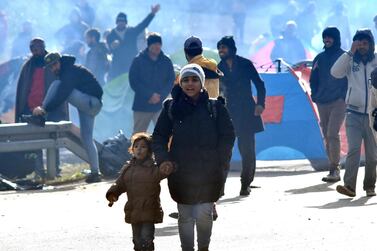More than 70 million people were forcibly displaced worldwide by the end of last year, the highest level seen in almost 70 years, the UN refugee agency said on Wednesday.
Half are children, many of them caught up in conflicts or persecution that world powers have been unable to prevent or end, United Nations High Commissioner for Refugees (UNHCR) said in its annual Global Trends report that marked World Refugee Day this week.
“What we are seeing in these figures is further confirmation of a longer-term rising trend in the number of people needing safety from war, conflict and persecution,” UN High Commissioner for Refugee Filippo Grandi said in a statement.
The overall figure of 70.8 million displaced people is double the level of 20 years ago, 2.3 million more than a year ago. It is equivalent to the population of Thailand.
Syrians fleeing the escalating conflict accounted for most of the world’s 13.6 million newly displaced people. The figure includes 10.8 million individuals displaced within the borders of their own country and 2.8 million new refuges and new asylum seekers.
More than two thirds of all refugees worldwide came from Syria with 6.7 million. Afghanistan has 2.7 million, South Sudan 2.3 million, Myanmar 1.1 million, and Somalia has 900,000.
The number of new displacements was equivalent to an average of 37,000 people being forced to flee their homes every day in 2018.
Lebanon continued to host the largest number of refugees relative to its national population, where 1 in 6 people was a refugee.
Jordan ranked second with 1 in 14 people being a refugee and Turkey came third with 1 in 22 people a refugee, the agency said.
By the end of 2018 there were 3.5 million global asylum seekers, who are individuals outside their country of origin and receiving international protection, but awaiting the outcome of their claim to refugee status.
Mr Grandi urged the international community to “come together for a common good” suggesting that the best solution for this crisis is for the refugees is to return home voluntarily, in safety and dignity.
The other alternative would be integration into the host community or being resettled to a third country.
However, only 92,400 refugees were resettled in 2018, less than 7 per cent of those awaiting resettlement, the report said.
Some 593,800 refugees were able to return home, while 62,600 became naturalised, the agency said.
Children carry the burden of war
In 2018, every second refugee was a child, including 111,000 alone and without their families. The agency said the figures are underestimated due to the limited number of countries providing data.
“Without the protection of family, unaccompanied and separated children are often at risk of exploitation and abuse,” UNHCR said.
In Iraq, the United Nations Children's Agency (Unicef) works in displaced camps to establish the identity of the children in hopes of reuniting them with their families.
For those whose parents cannot be identified, the agency works closely with the Iraqi government to provide them with the appropriate services.
Mohammed told Unicef aid workers in Iraq that he is half-French and half-Syrian.
"He does not remember where in Syria he is from, despite only having been in Iraq for two-and-a-half years. He said he went to school, in Mosul, but he will not – or cannot – give any more details," Unicef said in a report given to The National.
There are thousands of children – both Iraqi and foreign born – who are living in tents under the protection of the Iraqi state.
Unicef workers found four-year-old Salwa, with her blond ringlets shaking, and is upset because the other children are leaving. “Why are my friends going? Where are they going? Why are they leaving?” she asked.
Salwa was later reunited with her grandmother and baby brother.
Since the rise of ISIS in Iraq Unicef has been able to reunite 586 unaccompanied children with their primary caregivers.






